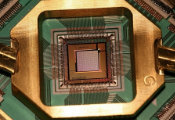New 28-Pixel Parallel SNSPD Design Achieves Breakthroughs in Photon-Number Resolution and Ultra-Fast Detection
July 22, 2024 -- Researchers from ID Quantique and the University of Geneva have made a significant advancement in superconducting nanowire single-photon detector (SNSPD) technology. A new 28-pixel parallel SNSPD (P-SNSPD) combines state-of-the-art photon-number resolution (PNR) and ultra-high-speed performance.
Key highlights:
- High detection rate with only a single coaxial read-out line: >50% SDE and 80 ps jitter at detection rates up to 200 Mcps
- State-of-the-art PNR: 75% efficiency for 2-photon events, 60% for 3-photon events, and accurate state reconstruction of Poissonian light at 40 MHz
- Simple, scalable readout: Just a single cryogenic channel per 28-pixel detector, no requirement for high-precision time-tagging, and the ability to discriminate photon numbers in real time without post-processing
Unlike conventional SNSPD arrays that require separate readout channels for each pixel, this design uses a parallel architecture in which all 28 pixels are connected on-chip, with photon-number information encoded in the amplitude of the output pulse. This allows the entire detector to be read out through a single coaxial cable, dramatically simplifying the experimental setup and improving scalability.
This P-SNSPD shows exceptional high-speed performance, maintaining a system detection efficiency (SDE) of over 50% even at count rates up to 200 MCps, with a timing jitter at that count rate of just 80 ps. Employing just four such detectors, utilizing only four cryogenic read-out channels, the researchers demonstrated a maximum count rate (MCR) of ∼1.3 Gcps. This combination of high-speed performance and minimal readout complexity put the technology in a strong position for applications requiring extremely high detection rates.
This parallel architecture allows for determination of photon number states without complex post-processing, simply based on discrimination of the amplitude of its output voltage. The use of many pixels allows scaling of n-photon fidelities close to the ideal ‘intrinsic’ scaling dictated by the device’s single-photon efficiency. This 28-pixel device thus achieves a state-of-the-art 75% efficiency for 2-photon events and 60% for 3-photon events, for example.
The team also successfully reconstructed the statistics of input coherent states at a 40 MHz repetition rate, showcasing the detector’s capabilities for quantum optics experiments.
The combination of high efficiency and low jitter at high count rates, scalable readout, and state-of-the-art photon number resolution makes many-pixel P-SNSPDs a versatile tool that could have far-reaching impacts on various quantum technologies: Quantum network applications, such as faster quantum key distribution systems; High-speed optical quantum computing protocols.
This groundbreaking technology is now commercially available as part of ID Quantique’s ID281 or ID281 Pro SNSPD systems, bringing cutting-edge photon detection capabilities to researchers and industry professionals worldwide.




































